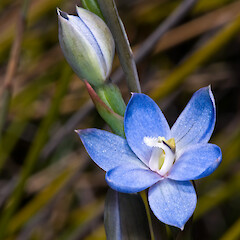Thelymitra aemula
Common name
gumland sun orchid
Synonyms
None
Family
Orchidaceae
Flora category
Vascular – Native
Endemic taxon
Yes
Endemic genus
No
Endemic family
No
Structural class
Orchids
NVS code
The National Vegetation Survey (NVS) Databank is a physical archive and electronic databank containing records of over 94,000 vegetation survey plots - including data from over 19,000 permanent plots. NVS maintains a standard set of species code abbreviations that correspond to standard scientific plant names from the Ngä Tipu o Aotearoa - New Zealand Plants database.
THEAEM
Chromosome number
2n = 40
Current conservation status
The conservation status of all known New Zealand vascular plant taxa at the rank of species and below were reassessed in 2017 using the New Zealand Threat Classification System (NZTCS) – more information about this can be found on the NZTCS website. This report includes a statistical summary and brief notes on changes since 2012 and replaces all previous NZTCS lists for vascular plants.
Please note, threat classifications are often suggested by authors when publications fall between NZTCS assessment periods – an interim threat classification status has not been assessed by the NZTCS panel.
- Conservation status of New Zealand indigenous vascular plants, 2017 . 2018. Peter J. de Lange, Jeremy R. Rolfe, John W. Barkla, Shannel P. Courtney, Paul D. Champion, Leon R. Perrie, Sarah M. Beadel, Kerry A. Ford, Ilse Breitwieser, Ines Schönberger, Rowan Hindmarsh-Walls, Peter B. Heenan and Kate Ladley. Department of Conservation. Source: NZTCS and licensed by DOC for reuse under the Creative Commons Attribution 4.0 International licence.
2017 | Not Threatened
Previous conservation statuses
2012 | Not Threatened
2009 | Not Threatened
2004 | Not Threatened
Distribution
Endemic. New Zealand: North Island (Te Paki to about the northern Waikato).
Habitat
Favouring open clay pans, gumland scrub, or sparsely vegetated slopes in site where there once was, or still is kauri (Agathis australis (D.Don) Lindl.) forest. It may also colonise grassy verges along roadsides traversing kauri forest remnants and gumland scrub. This species responds well to periodic burning provided of course the former habitat had few or no fire-adapted weed species.
Wetland plant indicator status rating
Information derived from the revised national wetland plant list prepared to assist councils in delineating and monitoring wetlands (Clarkson et al., 2021 Manaaki Whenua – Landcare Research Contract Report LC3975 for Hawke’s Bay Regional Council). The national plant list categorises plants by the extent to which they are found in wetlands and not ‘drylands’. The indicator status ratings are OBL (obligate wetland), FACW (facultative wetland), FAC (facultative), FACU (facultative upland), and UPL (obligate upland). If you have suggestions for the Wetland Indicator Status Rating, please contact: [Enable JavaScript to view protected content]
FAC: Facultative
Commonly occurs as either a hydrophyte or non-hydrophyte (non-wetlands).
Detailed description
Terrestrial, tuberous, robust, glabrous, late spring to early summer-green perennial herb, usually solitary or growing in small, diffuse colonies of 3–5 plants. Plants at flower up to 800 mm tall. Stem robust, fleshy, erect 2.5–3.5 mm diameter, dark reddish green. Leaf firmly fleshy to subcoriaceous, rather thick, erect to suberect, 80–260 × 3.5–10.0 mm, dark green, basally reddish, linear-lanceolate, channelled, prominently ridged, undersides smooth. Inflorescence a 3–10–(22)-flowered raceme. Bracts 2–(3), prominent, rather robust, short, sheathing, with divergent tips, dark reddish green. Ovary prominent, robust. Flower 10–18 mm diameter, closely spaced, segments pale mauve to dark sky blue. Sepals and petals subsimilar, oblong to ovate-oblong, apex obtuse or subacute. Labellum oblong-obovate. Column erect 4.8–5.6 mm tall, basally white grading through mauve to dark mauve, violet, or banded brown/dark violet near apex, apex yellow; post-anther lobe taller than anther, erect, smooth or minutely tuberculate on the back, margins denticulate, slightly recurved, yellow; side lobe scarcely evident, forward pointing, fleshy, yellow; column-arms laterally flattened, narrow, erect and upcurved (rarely horizontal), upper ⅔ fringed with numerous, thin, brush-like white cilia; the arms bent inwards such that the cilia meet above anther apex. Anther broadly ovoid, green, with a prominent long, narrowly tapered, acute apex. Stigma with a short, broad rostellum.
Manaaki Whenua Online Interactive Key
Similar taxa
Most likely to be confused with Thelymitra ixioides Sw., and T. tholiformis Molloy et Hatch, species with which it often grows. It differs from T. ixioides by its smooth rather than finely rugose leaf undersides; consistently unspotted flowers; yellow, denticulate, rather than purple, orange or reddish jagged post anther lobe furnished with numerous finger-like calli; and low forward pointing yellow, rather than high, erect, fleshy jagged purple or reddish yellow side lobes. From T. tholiformis it differs by its erect, non-hooded rather than tall, domed post anther lobe; presence of side lobes; and column arms bearing, thin brush-like rather than dense, globose cilia.
Flowering
November–February
Flower colours
Blue, Violet/Purple
Fruiting
December–April
Propagation technique
Difficult—should not be moved from the wild as it is strongly mycorrhizal and soon dies if moved from its habit.
Etymology
thelymitra: Woman’s hat
aemula: From the Latin aemula ‘rival’
Where To Buy
Not commercially available
Taxonomic notes
This species was included by Moore & Edgar (1970) in Thelymitra ixioides.
Attribution
Fact Sheet prepared for NZPCN by P.J. de Lange 14 April 2007. Description subsequently published in Rolfe & de Lange (2010).
References and further reading
Moore LB, Edgar E. 1970. Flora of New Zealand, Volume II. Indigenous Tracheophyta: Monocotyledones except Gramineae. Government Printer, Wellington, NZ. 354 p.
Rolfe JR, de Lange PJ. 2010. Illustrated guide to New Zealand sun orchids, Thelymitra (Orchidaceae). Jeremy Rolfe, Wellington, NZ. 57 p.
NZPCN Fact Sheet citation
Please cite as: de Lange, P.J. (Year at time of access): Thelymitra aemula Fact Sheet (content continuously updated). New Zealand Plant Conservation Network. https://www.nzpcn.org.nz/flora/species/thelymitra-aemula/ (Date website was queried)









